 April 2013 Tank of the Month
April 2013 Tank of the Month
April 2013 Tank of the Month
Joseph Peck's (JPMagyar) 240 US-gallon Reef Aquarium
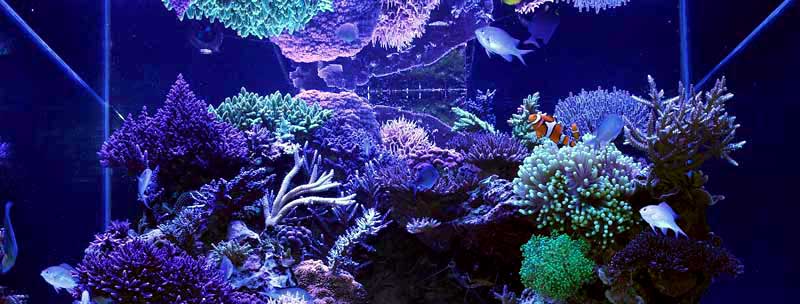 |
Introduction
There was a study done not too long ago where they took two groups of college students and paid them a few cents per job to build Lego models. The only difference between the two groups was that in one group the observing psychologist would disassemble the models as soon as the students finished building them and in the other group the students got to line up the models in front of themselves and admire their work. In both groups the students were told they could build and earn money for as long a time or as short a time as they felt like, and the question for the psychologists was would there be a difference in how many models the two groups were willing to build. Not surprisingly, the group that got to sit and admire their handy work built far more Lego models than the group that had their work taken apart. As an aquarist it's not so much that my models are being constantly disassembled, but when I spill 5 gallons of water on my floor, shock myself with a plug because my hand is wet when I put it in the wall, forget a coral trim on the living room floor and stink the house up, or contemplate 4 hours of work cleaning, scraping, hauling and wiping I wonder why the heck I'm doing this, but then when I sit down in front of my tank at night with a glass of wine in hand and marvel at the vibrant life right there in my own living room, the answer is clear. There is something about the beauty of a home aquarium that just makes all of us sit back and say "Wow", and that's the only reason I can see why we all work so hard at something that can at times seem like an endless chore.
Background
That concept of the endless chore was what drove me to build my latest reef in the way that I did. My first large reef was in a closed cabinet with limited space under the hood and so deep that reaching some parts of the reef bottom was all but impossible. Quite often I found myself allowing a pest to go undisturbed or a space of open rock to be unfilled because getting to that location was too difficult, and I rarely if ever trimmed or adjusted coral placement because it was just too much of a hassle. When I set about planning my new tank in 2007 I knew I wanted something that would allow me to touch every inch of the reef without having to resort to major furniture moving or using a step ladder and cramming myself into a hood and burning myself on hot lamps. This meant an open top tank, and since I had seen some recent examples of gorgeous rimless setups, I decided I'd try my hand at rimless. Lastly I wanted a somewhat open look, as my all time favorite aquarium was Steve Weast's monster tank known worldwide as the Oregon Reef. His tank show cased expansive areas of sand and lots of depth looking into the tank. I factored it all in. I wanted a rimless tank with extra width but low set so that it was easy to work on. I added to that the dimensions of the room and subtracted my loving wife's level of tolerance in having her home invaded by fish tanks and the answer became clear. I wanted a tank that was 48 x 48 x 24 inches.
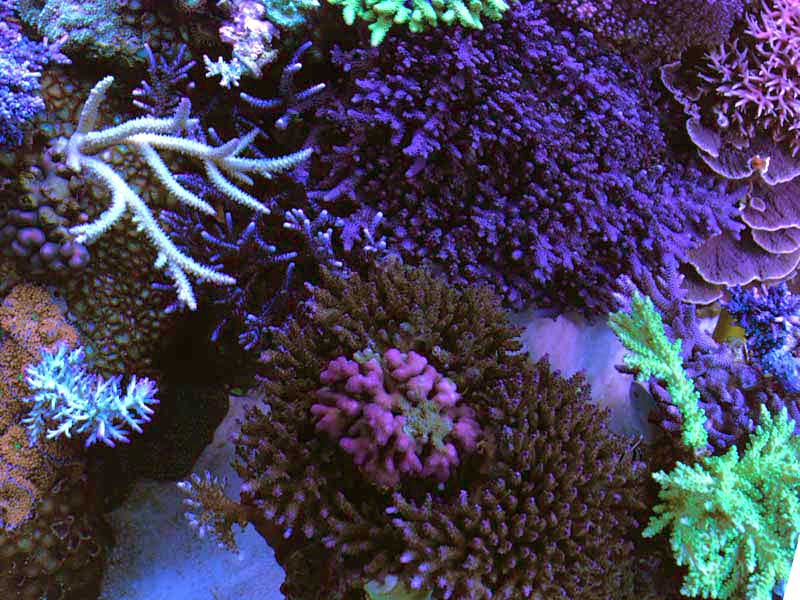 |
Current Tank
Happily for me or perhaps not so happily depending on one's outlook, I already had a reef in place so the behind the scenes decisions were already made. It became a matter of disconnecting the old and installing the new. Here I was incredibly lucky as my basement "fish room" came complete with a 300 gallon sump and 300 gallons of makeup water to use during the switch. The only other problem was that my new tank was a wee bit smaller than the old tank, and I wanted a more open architecture, so I would be needing to cut down my collection of corals if everything was going to fit, but part of my master plan in building the new reef was to focus on slow growing and visually stunning corals. Most of my favorite corals I already had, but I knew there were a few items I still hoped to collect and of course, I needed to consider space for future unexpected beauties. In the end, I didn't need to worry because the amount of space I had to work with was so large that initially the tank looked bare. I did allow a couple fast growers back into the reef, but I was careful to place them on rocks that were removable so I could take them out and start them over when they got too big. This has proved key as I have had to remove my purple nana colony twice already. Today if I were to start over I would go even more open and use even less rock work if I could because it is painfully clear now that coral frags need only small outcroppings from which to grow out rather than massive mounds and there is no denying that variable height in a reef adds to the visual impact. Regardless it all came together in September of 2007. With lots of help both paid and unpaid, I took down the old reef, installed the new tank, hooked up the water lines and brought out the corals I hoped would be the foundation of a beautiful new reef. With hindsight I know I probably should have started with all new rock and water, used smaller frags to repopulate the new reef, and been altogether slightly more patient because I ended up reintroducing a green palythoa and purple plating montipora that are today becoming the bane of my existence. Somehow they snuck in on the live rock that I reused from the original reef and have grown to take over large sections of my tank. Happily for me they haven't affected the overall beauty of the tank yet.
System Profile
• Display tank: 240 gallon Glasscages tank and stand (48in x 48in x 24in)
• Display Lighting: 150 Watt Radium x4 on Lumatek e-ballasts, 54 Watt ATI Blue Plus T5 x8, 54 Watt ATI Aquablue Special T5 x4, 54 Watt KZ Fiji Purple T5 x4
• Sump: 300 gallon Agway livestock trough
• Frag Tank: 180 gallon Oceanic tank and stand
• Calcium Reactor: MTC ProCal
• Skimmer: MTC HSA 1000 with Iwaki 100RLT pump
• Water Circulation: Iwaki 100RLT - half to display; half to frag tank (1000 gals/hr), Tunze Wavemaker, Tunze Turbelle Stream 2 x 6105 plus 2 x 6025
• Controller: Tunze 7094 Controller
• Filtration: 2 x Marineland Tidepool II sumps with trays
• Doser: Kent Marine gravity feed for B-Ionic 2 part dosing
• Auto Top Off: Maxijet 1200 feeding from 40 gal RO/DI holding tank (70 drips/min)
• Heater/Cooling: Ranco Controller with dual Jager 250 watt heaters and fan
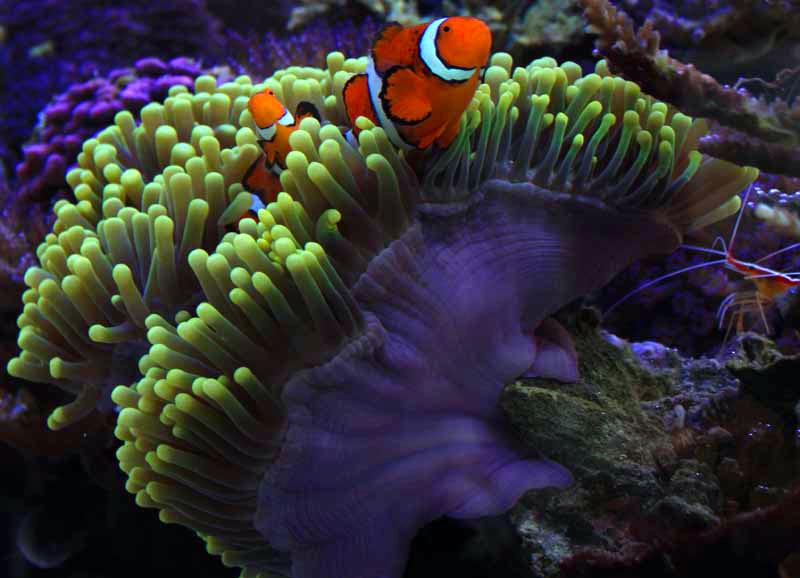 |
Filtration
Getting from the bare bones of 2007 to the garden of corals I have today hasn't been without some trials along the way, but I believe deeply that much of my success comes from two underlying philosophies: 1) I try to follow the KISS principle and 2) no matter the setbacks I never give up. One of the nice aspects of reef keeping is that there are as many ways to get to the end as there are beautiful tanks, but for me, part of the reason for going to this tank was to make my life easier and that meant a minimum use of gadgets and/or special additives. Reefers began to succeed at keeping colorful SPS when they combined skimmers, live rock, water changes, and good lighting. I am convinced that my focus on the basics is a large part of my success. I gravity feed my top off through a drip line to avoid controller failure. I never skimp on water changes, and I keep my skimmer in tip top shape running 24/7. I know there are plenty of wonderful reefs that have totally different philosophies and equipment, but sticking to what I was comfortable with seemed the best route for me. It is true I have played with different additions to the basics, but they seem to come and go on my whim without truly changing the reef, and I always fall back on the simple elements of the Berlin System as the heart and soul of my reef. I do admit though that some elements of my system maintenance may not be exactly routine when compared to most reefs. For starters I periodically vacuum my 300 gallon sump and I keep an extra 200 lbs of live rock in there that gets rinsed every month or so. Plus I have an additional 180 gallon frag tank which is also plumbed inline making for a total system volume of around 700 gallons, and without question having a large system volume keeps everything more stable. I clean my shallow sand bed constantly because I think clean sand is the number way to enhance the "wow" factor when seeing a tank in person. Every month I pull out my 4 Tunze's for a quick cleanup, and I constantly trim or even remove corals to insure adequate flow throughout the tank, and lastly I test frequently to insure that the water quality is as close to ideal as possible. Of course, maintaining ideal water in a reef is an art in itself beginning with the fact that few experts can agree on what the ideal is anyways. In my reef I shoot for imitating an Indonesian reef with 35 ppm salinity, 425 ppm Ca, alkalinity around 8 dKH, and phosphate and nitrate that are undetectable. Sometimes my nitrates do sneak up, and that is a frequent battle keeping them in check, but generally if I stick to my regular maintenance then all is well. Without question, the hardest challenge in keeping perfect water has been alkalinity.
|
Maintenance:
|
Supplements
Just as the cliché says, "we learn something new every day", my experience with reef keeping has been no different. My struggle with alkalinity is a good example as for years I tried dosing with B-Ionic two part, using a calcium reactor, and running my top off RO through a Deltec kalkwasser stirrer, but nothing seemed to hold the alkalinity steady and as a result I was continually testing and adjusting to keep the water parameters stable until I finally found a website created by J. Dieck that put into strict methodology the means to set and check my calcium reactor to output the right amount of effluent with the right amount of calcium hardness to keep my alkalinity stable. Since then I do add B-Ionic now and again to get the alkalinity just right, but now my additions are once a week at most and are a mere fraction of the total amount I was once dosing. The calcium reactor does take some monitoring as my philosophy of KISS doesn't allow me to connect it to a controller; so I am certain I am not using CO2 as efficiently as I could and my tank has definitely come down in pH since upping the reactor effluent output, but all that seems a small price to pay for stable alkalinity especially now that recent research has convinced me that keeping normal or even slightly elevated levels of carbonate hardness in our reefs is absolutely key to growing healthy SPS. It's always interesting to me how lighting seems to be the number one focus of most reefers when items such as alkalinity are equally if not more important than lighting to achieving a healthy tank.
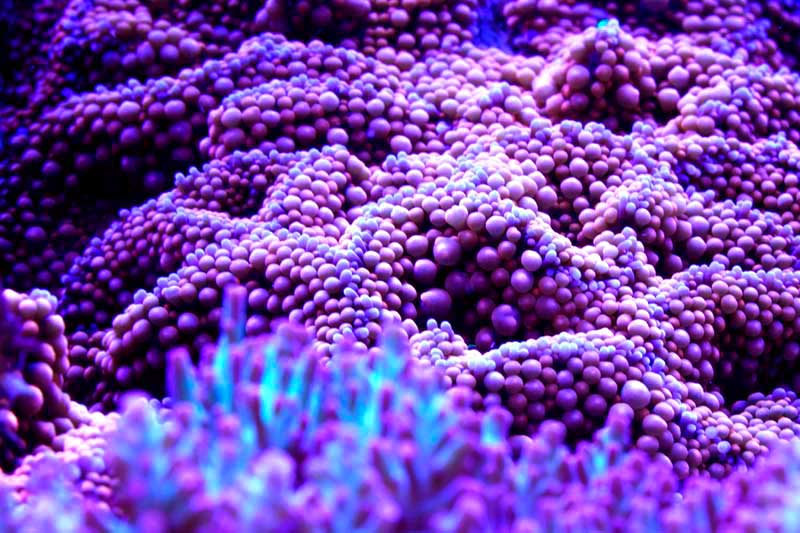 |
Lighting
Lighting for me was always an easy answer at least with this newest of tanks. Early in my reefing career I tried nearly every combination available including 1000 watt metal halide bulbs that burned and cracked the top of my acrylic reef back in 2003, but by the time I set up my current reef I had become a dedicated believer in the benefits of 400 watt Radium bulbs. I admit I have expressed my opinion on lighting a bit too vociferously over the years especially here on RC, and I now accept that lighting is a very personal selection that we all need to make based on our personal preferences, but at the end of the day I don't understand why anyone keeping SPS would want to use anything other than Radiums or T5s except to save money on electricity because to me nothing grows SPS as fast, as completely, or as colorfully as one of these two lighting choices, but before you PM me all the reasons why your lights are better please keep in mind that I agree absolutely and unequivocally that there are as many ways to light a reef tank as there are reefers in America, and all of them can work just fine. It's just that I have my favorite for sure. Actually my choices in lighting have evolved over the last couple years as I went from an original setup with 4 x 400 watt Radiums plus 4 x 110 watt UVL Super Actinic VHOs to the same setup only 4 x 250 watt Radiums and 4 additional ReefBrite Blue supplemental LEDs to what I have today which is 2 new Sfiligoi fixtures each having 8 x 54 watt T5s and 2 x 150 watt Radium HQI metal halides, and quite honestly I made the switch purely out of reef envy. I kept coming across pictures of Krzysztof Tryc's SPS tank, and I knew he used only T5s. Since making the jump to T5s I will say that at first I felt they were really an improvement, but as time has passed I'm not sure that they are really "that" different and trying to match the beauty of Krzysztof may be more about coral selection than the lighting. Either way I like what I have, but don't be surprised if you see a future update where I go back to my old favorite 400 watt metal halide Radiums, but then that's what's great about our hobby today we have so many choices unless, of course, you are just starting out.
|
Water Parameters:
|
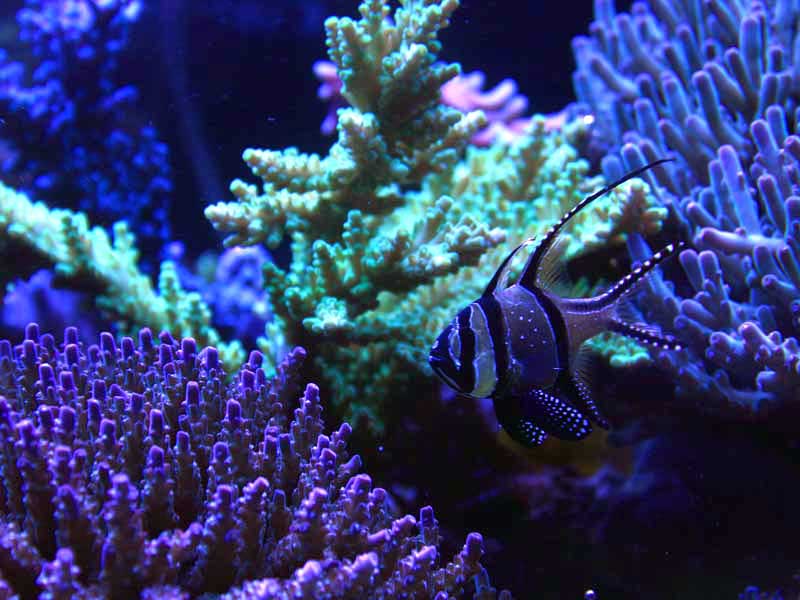 |
Livestock
|
Fish:
|
|
Corals:
|
Acknowledgment
As a last word of advice, I want to speak to those who may be working on their first reef. Anyone that has followed my posts online will recognize this next philosophy as one that I espouse constantly because to me it seems so simple. For some folks designing and building the reef is more than half the pleasure and my biggest piece of advice is not for them. If, on the other hand, you are like me and what you really want is a beautiful slice of ocean in your living room then my advice is simple . . . copy someone else. Almost every shape, size, biotope, and cost variation a reefer can imagine has been tried by someone else, and if you really want a nice tank with minimum hassle all you have to do is find one you like and do EXACTLY what they are doing. For me the friends I have made in studying other reefs here on RC and in the world around me has been a tremendous pleasure, but if I had just built the tank that I first intended exactly as my first mentor Chris Jessen had in his shop in Stamford, I could have saved myself an lot of money, but then if you are trying to save money I recommend you take up surfing or snorkeling because reef keeping is an expensive lifelong addiction for sure!
Thanks RC. You're the greatest!
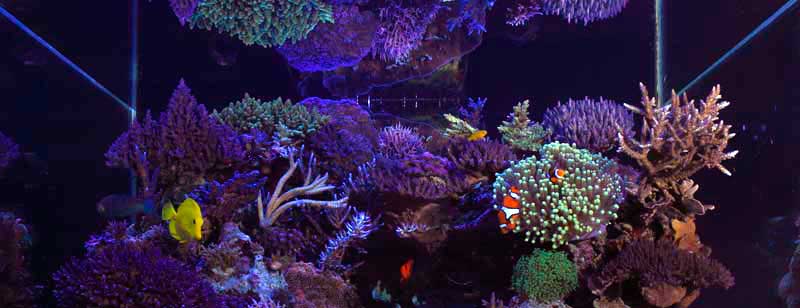 |
Feel free to comment or ask questions about my tank in the Tank of the Month thread on Reef Central.



